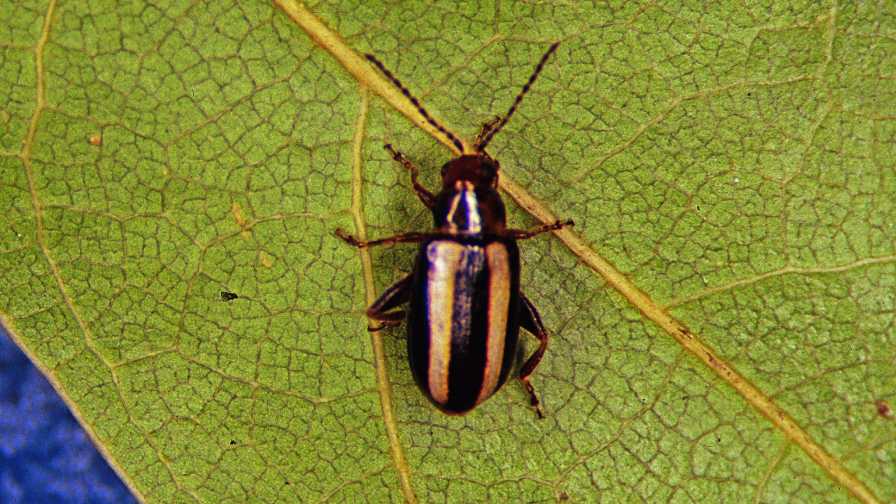This latest edition of American Vegetable Grower magazine’s Field Scouting Guide concentrates on palestriped flea beetle (Systena blanda).
John C. Palumbo, University of Arizona, shares tips on how to spot and treat for this pest.
BASICS
- Scientific name: Systena blanda
- Common name: Palestriped flea beetle
- Geographical Range: You can find the flea beetle pest throughout the western U.S.. It’s particularly troublesome on vegetable and melon crops in the desert growing regions of Arizona and California.
- Crops affected: The palestriped flea beetle is the most destructive flea beetle species attacking vegetable crops. Palestriped flea beetle has a wide host range and is an important pest in all leafy vegetables. This includes lettuce, celery, spinach, cole crops, carrots, and melons, particularly during the fall growing season. You can also find it on field crops including alfalfa, cotton, Sudangrass. It even infests numerous weed species, including purslane, nightshade, and pigweed.
The adult beetle is highly mobile and disperses readily from field crops and weeds onto emerging vegetable crops. They are most active on warm and sunny days.
PEST IMPACT
Palumbo: Palestriped flea beetle are an annual pest of leafy vegetables and melons. It infests vegetables throughout the desert southwest (Arizona, California, and northern Mexico).
Adult palestriped flea beetles do most of the damage on leafy vegetable and melons crops. Larvae generally do not damage vegetable crops or melons, except for carrots. On carrots, larvae will feed on developing crops, rendering them unmarketable.
Feeding damage to cotyledons and young leaves is the major cause of crop loss. Adults feed on both sides of leaves, creating small scars or irregularly shaped holes. They have chewing mouthparts and are capable of consuming large amounts of leaf tissue in a short period of time. Seedling crops at the cotyledon stage are most susceptible, and palestriped beetles can devour entire cotyledons or outright kill small seedlings.
If left unprotected, transplants and larger seedling plants can sustain significant feeding damage on the terminal growing points or newly emerged leaves. Not only can this feeding stunt plant growth, but it also can result in lack of stand uniformity and crop maturity at harvest in head lettuce, romaine, and cole crops.
Older plants rarely suffer economic damage; but feeding on lettuce and spinach leaves can cause cosmetic damage and seriously reduce quality.
IDENTIFICATION
Palumbo: Palestriped flea beetles have a pair of pale-yellow stripes along the back, one on each elytron. And it can be confused with the stripped cucumber beetle (Acalymma vittatum). Palestriped flea beetles are about half the size of cucumber beetles. But both beetle species cause similar damage to seedlings plants. Feeding damage on cotyledons and young leaves of lettuce and spinach also can be mistaken for feeding by beet armyworm (Spodoptera exigua).
RECOMMENDED TREATMENT
Palumbo: In conventional production, contact insecticides applied via overhead sprinkler chemigation (e.g., pyrethroids) or foliar sprays (e.g., methomyl) can cost-effectively minimize flea beetle abundance and damage to leafy vegetable and melon crops during stand establishment.
| Name | Brands | Active Ingredient | IRAC Group | Mode of Action |
| Pyrethroid | Brigade Asana Warrior genetics | bifenthrin esfenvalerate lambda-cyhalothrin others | 3A | Neurotoxin Sodium channel modulator |
| Carbamate | Lannate (Corteva) | Methomyl | 1A Acetylcholinestrase inhibitirs | Neotroxin |
| Neonicotinoid | NipsIT seed treatment | Clothianidin | 4A Nicotinic acetylcholine receptor agonists | Neotroxin |
Atplanting, soil systemic neonicotinoid (e.g., Admire Pro – Bayer, Venom – Valent USA) and diamide (e.g., Durivo – Syngenta, Coragen – FMC, Verimark – FMC) insecticides do not adequately control flea beetles on newly transplant crops or emerging direct seeded crops. However, insecticide seed treatments are available for lettuce and broccoli that will protect stands from flea beetles (e.g., NipsIt – Valent USA).
In organic production, control of palestriped flea beetle is challenging. A tank mixture of Entrust (Corteva) and M-Pede (2%, Gowan Co.), and Pyganic (MGK) have shown to provide fair efficacy in organic crops. Repeated applications are often required to provide marginal levels of plant protection.
| Name | Brands | Active Ingredient | IRAC Group | Mode of Action |
| Tank-mix combination of Entrust with M-Pede | Entrust M-Pede | Spinosad potassium salt of fatty acid | 3A | Neurotoxin Nicotinic acetylcholine agonist (Entrum) Suffocation (M-Pede) |
| Pyrethrin | Pyganic | Pyrethrin | 3A Sodium channel modulators | Neotroxin |
IPM RECOMMENDATIONS
- Cultural Control: It is important to control weeds in and around the field that can host flea beetles. Sudangrass, alfalfa, and cotton can harbor large number of beetles. So it is important to destroy plant residue immediately after harvest if you plan to grow leafy vegetables or melons nearby. In Arizona and southern California, experience has shown that leafy vegetables and melon fields planted adjacent to these crops or weedy areas are at a high risk from palestriped flea beetle. As summer crops are harvested or terminated, the adults typically move to the next available host crops; leafy vegetables, cole crops, and melons.
- Biological control: There are no natural predators or parasites that can effectively control flea beetle populations or prevent their damage on seedling vegetables and melons under desert growing conditions.
- Monitoring and Sampling: Monitor newly emerged seedlings frequently during stand establishment for flea beetle damage until plants are well established. Relatively low populations can cause economic damage when plants are in the cotyledon or first true-leaf stage.
- Chemical Control: Treat with an insecticide if you find several damaged plants throughout the field or if populations of beetles are high. A single insecticide application is usually sufficient. But under heavy beetle pressure, repeated sprays might be necessary to control new beetles that re-invade the field from outside host sources.

